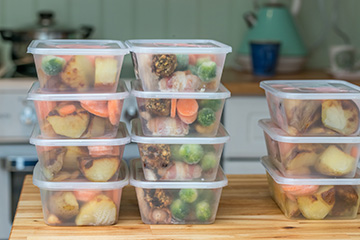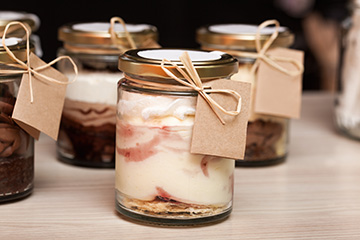
Prepare Now for Stress-Free Holidays

The weather is getting cooler, ushering in fall festivals and football to enjoy. The holidays will be upon us before you know it. So take some time now to reduce the stress of the holiday season by freezing some family favorites that will help you make a quick meal. Planning ahead to freeze prepared foods is a great way to keep homemade food on your dinner table without all of the stress and hassle.
Freezing is the easiest way to preserve food. As with all food preservation, start with high-quality food to achieve the best results. Food texture, flavor and quality can change with freezing because of the nature of the process; some factors that have an effect include water content, freshness and the type of packaging. Hot foods take longer to freeze, so start with room temperature or chilled foods to speed up the freezing time. Use freezer-safe packaging such as resealable freezer bags; sturdy plastic freezer containers; wide-mouth canning jars; freezer-to-oven baking dishes; or freezer paper. Label the package with the name of the food, date packaged and any other relevant information. Verify your freezer temperature with a refrigerator/freezer thermometer so that it is 0 degrees F or colder to help foods freeze quickly.
While you can cook some foods from their frozen state — such as casseroles — it is usually best to thaw them first. The refrigerator is ideal. Place raw meats on a plate or tray to catch any juices. Another option is to submerge the frozen raw meat in cold water, changing the water every 30 minutes, until the food is thawed. Baked goods, like bread or cookies, can be thawed at room temperature.
We wish all of you a stress-free holiday season with your family and friends!
Sources:
National Center for Home Food Preservation. 2017. Freezing ahead for the holidays, November 17. https://preservingfoodathome.com/tag/holidays/.
K-State Research and Extension. "Freezing." http://www.rrc.k-state.edu/preservation/freezing.html.

Cakes and Breads in Jars: Are They Safe?
As the holidays approach, recipes for “canned” breads and cakes seem to appear with greater frequency in social media feeds and internet searches. While items like these might seem to fit the bill for that perfect unique gift, this type of product also has the potential to deliver a dangerous dose of foodborne illness.
Typical preparation instructions for these types of products include pouring prepared batter into greased glass canning jars and baking them in the oven. Once the product is baked, the hot jars are taken out of the oven and covered with canning jar flats and rings which, upon cooling, appear to create a vacuum seal.
The specific food safety concern in these types of products involves a microorganism known as Clostridium botulinum. This microorganism is abundant in nature, but only grows and produces toxins in unrefrigerated high moisture foods that are low in acid (with a pH of 4.6 or above) and exposed to little or no oxygen. If spores of these bacteria are allowed to germinate and grow, the potentially deadly botulinum toxin is produced.
The above-mentioned process for “canned” breads is an ideal example of a low-acid, high-moisture, low-oxygen product, creating a perfect environment for the growth of Clostridium botulinum spores. Researchers at Penn State University have determined that canned bread or cake products created in this manner can indeed support the growth of this dangerous pathogen. Even minute amounts of this toxin can cause the often-fatal disease called botulism.
In addition to the risk of botulism, you also run a significant risk of injury from broken glass if you bake cakes and breads in glass canning jars. Canning jars are designed for wet use in boiling-water bath, steam or pressure canners. In dry oven heat, glass jars can be subject to thermal stresses that can result in spontaneous breakage.
An alternative and equally appealing gift could be a special “mix in a jar.” Consider some of your own personal favorite recipes for which the dry ingredients can be layered into a jar. Some recipes might even create visual interest with colors or textures, based on ingredient variety. Finish the gift by attaching a tag or recipe card that includes directions for adding required ingredients along with complete preparation and baking instructions. Consider that some ingredients, like brown sugar, might harden over time. Other ingredients, like nuts or dried fruits, can cause dry ingredients to clump together. If your mix includes ingredients for a topping, as on a coffee cake, you can package them separately in a small plastic bag and place them on top of the other dry ingredients.
Because home-prepared mixes contain no preservatives and leavening ingredients like baking powder lose their effectiveness over time, it is a good idea to include a “use by” date on your label. One to two months from the time you prepare your mix is an appropriate use by date.
Adapted by permission from Clemson University Cooperative Extension. “Cakes and breads in jars — Are they safe?" https://www.clemson.edu/extension/food/canning/canning-tips/36cakes-breads.html.
Labeling Holiday Canned Food Gifts
 Canned foods can make great gifts, but it is critical that these gifts are safe and that the giver communicates essential information about the gift to the recipient. Therefore, it is recommended that you label your canned food gift with the following information:
Canned foods can make great gifts, but it is critical that these gifts are safe and that the giver communicates essential information about the gift to the recipient. Therefore, it is recommended that you label your canned food gift with the following information:
- The product creation date (recommend use of home-canned foods within a year of their creation date)
- The ingredients (particularly helpful for people with food allergies)
- Storage and handling instructions, such as:
- Store in a cool, dry place. Refrigerate after opening (essential for all canned products)
- Discard if lid seal is broken or “popped” up (again, essential for all canned products)
- Keep refrigerated (if it is a product requiring refrigeration for safety)
- Cooking instructions (if applicable)
- Ideas or tips on how to use the gift
If canning foods for room temperature storage, be sure to always use and completely follow only safe, tested recipes from research-based resources such as the National Center for Home Food Preservation, the U.S. Department of Agriculture or university extension systems. The recipient can add additional ingredients after opening the jar, but you must follow the recipe precisely before canning to ensure the food is safe.
Source:
Nummer, Brian A. July 2003. Resources for home food preservation gifts. https://nchfp.uga.edu/tips/winter/hfp_gifts.html. (No longer available online.)